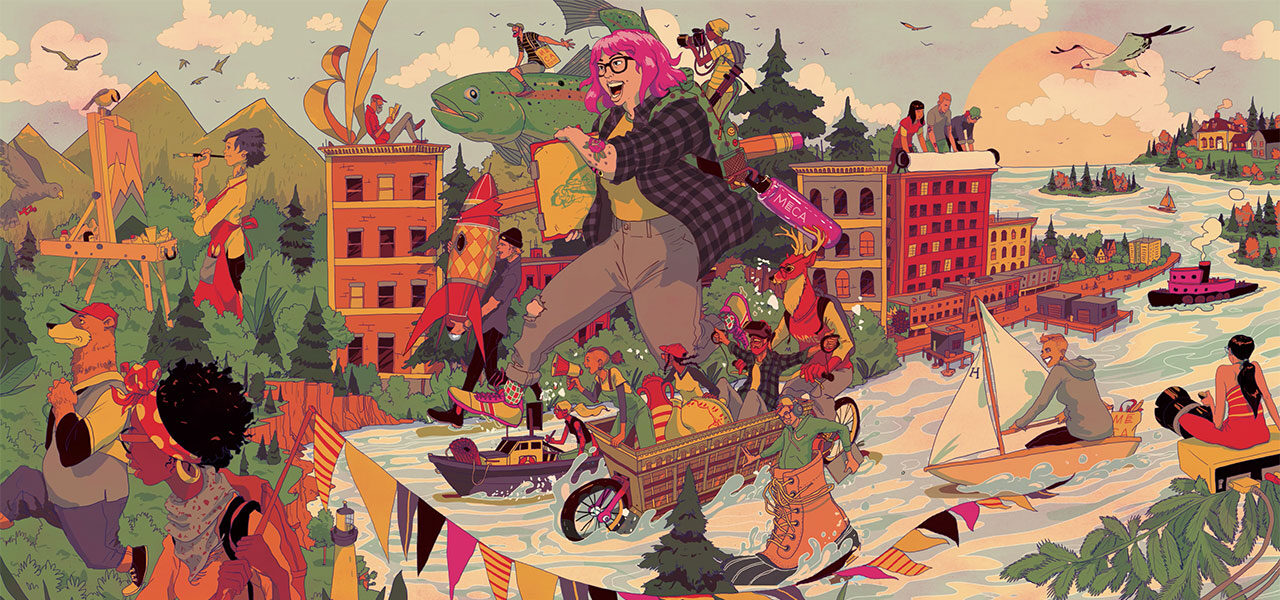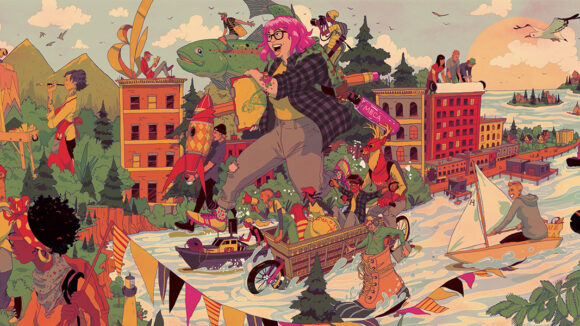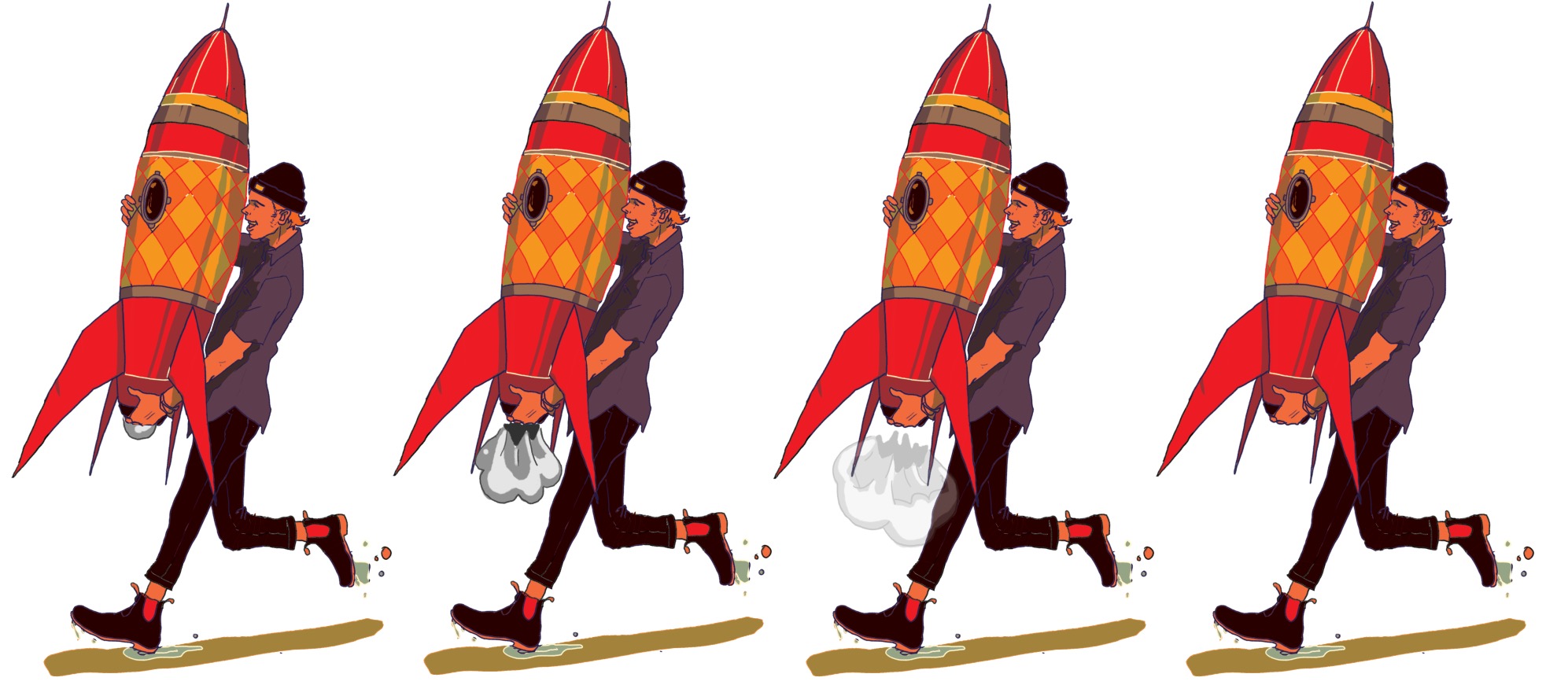

How Two Animation & Game Art Seniors At Maine College Of Art Transformed The School’s Homepage
A 10:1 student-to-faculty ratio. A campus in the arts district in the intimate city of Portland, Maine. A long history of public engagement and community partnerships throughout the state. In many ways, Maine College of Art (MECA) is perfectly set up to give its students, alumni, and faculty opportunities to show their artwork to the world.
That commitment is at the heart of MECA’s Be Seen initiative. As part of the initiative, Animation & Game Art seniors Ruthie Harrison (2021) and Richie Ward (2021) worked to create the school’s interactive meca.edu homepage, using animation to bring artwork by professional illustrator Michael Byers to life. Harrison and Ward were supervised by master animator Adam Fisher, the school’s Animation & Game Art Chair.
Below, Harrison and Ward speak to Cartoon Brew about their work, influences, and aspirations.
Cartoon Brew: Tell us a little bit about your interest in animation.
Richie Ward: I came to MECA to pursue my interest in designing video games. Since I was a kid, I’ve always loved creating things, especially things that can move. Pursuing this, with the support of my family, I’ve been able to get to the point I am today where I’m now designing a video game. It’s going really well and I’m very excited.
Ruthie Harrison: I originally came to MECA not really knowing exactly what I wanted to do. I was leaning toward studying animation because I’ve done a lot of messing around with stop motion since fourth grade — I’ve been doing it for half my life. It felt like magic. I’ve always had an obsession with tiny things and miniatures my whole life as well. Stop motion is the grown-up version of my childhood interests, and I would like to build props and sets for games or movies in the future.
What made you want to study at Maine College of Art?
Ward: I’ve always wanted to give back to the gaming community. So to be able to have these resources and people to connect with is basically why I’m here at MECA. Studying foundations gave me the ability to learn more about how to do art and put me where I am today.
Harrison: I looked at a lot of different schools. They were all really huge or in really big cities, and a lot of the art schools had similar things to offer. I could not see myself living in Boston or too far from home. Portland felt just big enough, so that I was moving somewhere new and exciting but not overwhelming.
I also really liked that MECA did not force you to choose your major right away, because even though I was pretty sure I wanted to do animation, I wanted to test out mediums I didn’t have the opportunity to test before. So I tried printmaking and textiles and I still went back to animation, but all of those things led to my current practice.

How did you get involved in the Be Seen initiative?
Harrison: I had just taken Adam Fisher’s Character Animation class, and I remember being nervous because I hadn’t done a lot of 2d animation. It was technically a step up from the Intro to Animation class, which Adam said I could skip, since I already had those tools. I work closely with him because his expertise is stop motion and, as a result, he recommended me for the Be Seen project.
Ward: I was also approached by Adam. That’s the great thing about having these kinds of resources at MECA. People notice the work you do and it’s really heartening.

What was it like to work on the Be Seen animation? What technical tools did you use and what did you learn?
Ward: Most of the work that I did was in After Effects and Photoshop. Usually, what we would do during the process was talk about how we could keep Michael’s vision for the original illustration alive. That was followed up by Ruthie 2d-animating some aspects, then sending roughs to Michael to have them drawn over and colored. This allowed us to keep the look consistent with the rest of the illustration.
I would then puppet some aspects so that it would speed up the process. It helped us think about how efficient we could be during a timeline. The experience of using After Effects was quite nice because I got to use it in this professional environment. I just had a class the semester before for After Effects, and the software program is really powerful. I’m just really glad I got to learn it and be part of this.
Harrison: I did more of the drawn 2d animation and Richie did the Adobe After Effects post-production conglomeration of everything. I had to take a step back from what I had learned, because I originally learned 2d animation in Toon Boom, but working in Adobe Photoshop was easier for Michael to work with. There were some of the animations that I felt comfortable coloring in, but ones with more detail we wanted him to be able to fill in.
Richie, I thought it was incredible, all the stuff you were able to figure out in this timeline. The puppeting was really impressive and we had to work together on some of the animations. The hardest one from my perspective was the string of flags — all of it had to work together. I animated the flags flapping, then it was colored over, then Richie took it and made my animations and the string actually wave. Richie went through about 10,000 iterations before he was satisfied! The flags were the most time-consuming, but I am so proud of it.
Ward: The flag was my favorite because of how many possibilities there were. The hardest piece to me was the pink-haired person’s shirt. That was difficult because it was a plaid pattern and to reanimate it to flow and to have to redraw plaid was not fun. So I worked with puppeting to keep it consistent.

What are some highlights of your year studying Animation & Game Art at MECA?
Harrison: This year has been weird, obviously. We just got new Animation & Game Art space downstairs, and having that extra space has allowed the three of us who are working in stop motion for our senior thesis to have our own little black curtain boxes with stages to build everything on.
I’ve been able to interact with a lot of different departments making the pieces for my set — I used the Woodworking & Furniture studios and MECA’s Fab Lab, for example, to laser-cut pieces for a set piece, and the CNC router machine to cut out the pieces. Everyone was really helpful and excited to collaborate. That’s why I like stop motion so much, because it doesn’t trap me on the computer — I can still make things with my hands, which I really like to do.
Ward: When I got to MECA I didn’t know exactly what I would do, since the Animation & Game Art Major grew out of the former Digital Media major. As soon as that change happened, I was like, wow, what I want to do for a career — what I’ve always wanted to do — is possible.
Through exploring all these programs and ideas and working with other people, I found that my vision could come to life through the resources that were available to me. The most valuable resource is the other students. They’re basically your family at MECA.
Harrison: Everyone’s really happy to help. In the stop-motion studios, people can collaborate, share, and borrow. We all want to help each other. It doesn’t matter how close you are to anyone — we’re all banking on everyone else’s success. That’s a really good feeling, to feel like everyone believes in you and you believe in everyone.
Ward: I agree with that entirely.
What is the environment like in Animation & Game Art, and how were you influenced by master animator and Department Chair Adam Fisher?
Ward: The environment for the department is very nice because there’s multiple rooms and plenty of accessible tools and software. It’s very helpful — I know most students don’t have access to this kind of software or tech, because it can be expensive. As for Adam Fisher inspiring us, I’m pretty sure everyone is just completely blown away that Adam is even here. We’re just so grateful — he’s a genuinely nice human being who wants to see us do really great things and it’s so wonderful.
Harrison: I totally agree. I like having the bigger space this year. The way we’re doing the classes this year, we’re meeting in person but doing critiques on Zoom. There are lots of different materials and technology to be using.
As far as Adam goes, Coraline [one of seven feature films Fisher has worked on] was the movie that made me realize I could do stop motion as a career, so it kind of changed my whole life. But, yeah, I realized he was this super down-to-earth person who wants us to succeed and who has been a great mentor for the past three years.
Tell us about your senior thesis work.
Ruthie: Essentially, mine is a stop-motion animated film. I wanted to focus on the topic of anxiety and depression, but without demonizing it. There are short films you see where someone is dealing with those things and there’s a big monster or dark, looming object and they have to defeat it. I wanted to kind of approach it as something that you have to live with — it’s a part of you: love it, take care of it, it’s something you have to learn to deal with.
So I am focusing on how anxiety and depression plants itself in you as a child, and I took the word “plant” literally. My character receives a seed as a child and the plant grows large and overwhelming, and restrains her. When she learns to take care of it and trim it away — not get rid of it or kill it, but nurture it — she’s able to live a normal life. I felted the whole puppet and am cutting out tiny felt leaves and flowers. I wanted it to have a more welcoming and soft feel to it, rather than dark and scary.

Ward: The work that I’m doing is very taxing. Let’s just say there’s a lot to do because I’m making a video game that requires 3d modeling, texturing, animation, testing, programming, story, and more. My initial goal is to make a game demo to have as an inspiration to keep working on it, because games can take 2–7 years just to create, and that’s when you have a large team.
So far, I’ve made a really beautiful desert landscape and I’m trying to code in a day-and-night cycle so the environment changes. I have a character that is a sorcerer, and there are huts and caves and cacti and bushes. It’s really awesome to see the assets you create be put into an environment that you can just walk around in.

Harrison: The rigging and animating of that character is really amazing. It’s a little man, a hyper-realistic man that has bones and facial expressions! So don’t sell yourself short!
MECA’s Be Seen homepage animation project is just one example of student work in the Animation & Game Art Program at Maine College of Art in Portland, Maine. To learn more about the Animation and Game Art program curriculum, click here. The priority deadline to apply to MECA for the Fall 2021 class is March 1, 2021. Apply here.
Go to meca.edu to see how Animation & Game Art seniors Ruthie Harrison (2021) and Richie Ward (2021) transformed MECA’s homepage via an independent project with Adam Fisher, stop-motion animator and Assistant Professor of Animation and Game Art at MECA.
Other Be Seen project team members: creative direction by Drew Design Co., creative copy by The VIA Agency, website homepage interactivity design by VONT.
Artwork at top: Be Seen Homepage Illustration by Michael Byers, 2020.
